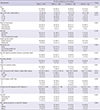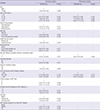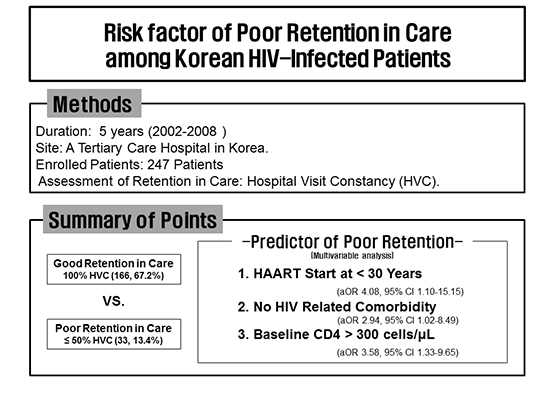1. Horstmann E, Brown J, Islam F, Buck J, Agins BD. Retaining HIV-infected patients in care: where are we? Where do we go from here? Clin Infect Dis. 2010; 50:752–761.
2. Giordano TP. Retention in HIV care: what the clinician needs to know. Top Antivir Med. 2011; 19:12–16.
3. Stricker SM, Fox KA, Baggaley R, Negussie E, de Pee S, Grede N, Bloem MW. Retention in care and adherence to ART are critical elements of HIV care interventions. AIDS Behav. 2014; 18:Suppl 5. S465–S475.
4. Thompson MA, Mugavero MJ, Amico KR, Cargill VA, Chang LW, Gross R, Orrell C, Altice FL, Bangsberg DR, Bartlett JG, et al. Guidelines for improving entry into and retention in care and antiretroviral adherence for persons with HIV: evidence-based recommendations from an International Association of Physicians in AIDS Care panel. Ann Intern Med. 2012; 156:817–833.
5. Patel A, Hirschhorn L, Fullem A, Ojikutu B, Oser R. Adult adherence to treatment and retention in care. Arlington, VA: USAID/AIDSTAR-ONE;2010.
6. Mugavero MJ, Lin HY, Willig JH, Westfall AO, Ulett KB, Routman JS, Abroms S, Raper JL, Saag MS, Allison JJ. Missed visits and mortality among patients establishing initial outpatient HIV treatment. Clin Infect Dis. 2009; 48:248–256.
7. Giordano TP, Gifford AL, White AC Jr, Suarez-Almazor ME, Rabeneck L, Hartman C, Backus LI, Mole LA, Morgan RO. Retention in care: a challenge to survival with HIV infection. Clin Infect Dis. 2007; 44:1493–1499.
8. Lucas GM, Chaisson RE, Moore RD. Highly active antiretroviral therapy in a large urban clinic: risk factors for virologic failure and adverse drug reactions. Ann Intern Med. 1999; 131:81–87.
9. Robbins GK, Daniels B, Zheng H, Chueh H, Meigs JB, Freedberg KA. Predictors of antiretroviral treatment failure in an urban HIV clinic. J Acquir Immune Defic Syndr. 2007; 44:30–37.
10. Sethi AK, Celentano DD, Gange SJ, Moore RD, Gallant JE. Association between adherence to antiretroviral therapy and human immunodeficiency virus drug resistance. Clin Infect Dis. 2003; 37:1112–1118.
11. Lee SH, Kim KH, Lee SG, Cho H, Chen DH, Chung JS, Kwak IS, Cho GJ. Causes of death and risk factors for mortality among HIV-infected patients receiving antiretroviral therapy in Korea. J Korean Med Sci. 2013; 28:990–997.
12. Choi JY, Park YS, Kim CO, Park YS, Yoon HJ, Shin SY, Kim YA, Song YG, Kim JM. Correlation between adherence to antiretroviral treatment and virologic failure in HIV-infected Koreans. Infect Chemother. 2005; 37:9–15.
13. Kim YJ, Lee WK, Kim SW, Chang HH, Lee JM, Kim SJ. Impact of self-efficacy on medication adherence among people living with human immunodeficiency virus. Korean J Med. 2015; 89:305–311.
14. Mugavero MJ. Improving engagement in HIV care: what can we do? Top HIV Med. 2008; 16:156–161.
15. Mugavero MJ, Davila JA, Nevin CR, Giordano TP. From access to engagement: measuring retention in outpatient HIV clinical care. AIDS Patient Care STDS. 2010; 24:607–613.
16. Centers for Disease Control and Prevention. 1993 revised classification system for HIV infection and expanded surveillance case definition for AIDS among adolescents and adults. MMWR Recomm Rep. 1992; 41:1–19.
17. Charlson ME, Pompei P, Ales KL, MacKenzie CR. A new method of classifying prognostic comorbidity in longitudinal studies: development and validation. J Chronic Dis. 1987; 40:373–383.
18. Skiest DJ, Rubinstien E, Carley N, Gioiella L, Lyons R. The importance of comorbidity in HIV-infected patients over 55: a retrospective case-control study. Am J Med. 1996; 101:605–611.
19. Mallinson RK, Relf MV, Dekker D, Dolan K, Darcy A, Ford A. Maintaining normalcy: a grounded theory of engaging in HIV-oriented primary medical care. ANS Adv Nurs Sci. 2005; 28:265–277.
20. Israelski D, Gore-Felton C, Power R, Wood MJ, Koopman C. Sociodemographic characteristics associated with medical appointment adherence among HIV-seropositive patients seeking treatment in a county outpatient facility. Prev Med. 2001; 33:470–475.
21. Krishnan S, Wu K, Smurzynski M, Bosch RJ, Benson CA, Collier AC, Klebert MK, Feinberg J, Koletar SL. ALLRT/A5001 Team. Incidence rate of and factors associated with loss to follow-up in a longitudinal cohort of antiretroviral-treated HIV-infected persons: an AIDS Clinical Trials Group (ACTG) Longitudinal Linked Randomized Trials (ALLRT) analysis. HIV Clin Trials. 2011; 12:190–200.
22. Giordano TP, Hartman C, Gifford AL, Backus LI, Morgan RO. Predictors of retention in HIV care among a national cohort of US veterans. HIV Clin Trials. 2009; 10:299–305.
23. Lebouché B, Yazdanpanah Y, Gérard Y, Sissoko D, Ajana F, Alcaraz I, Boitte P, Cadoré B, Mouton Y. Incidence rate and risk factors for loss to follow-up in a French clinical cohort of HIV-infected patients from January 1985 to January 1998. HIV Med. 2006; 7:140–145.
24. Min JA, Yoon Y, Lee HJ, Choi J, Kwon M, Kim K, Lee CU, Kim DJ, Yun H. Prevalence and associated clinical characteristics of hepatitis B, C, and HIV infections among injecting drug users in Korea. J Med Virol. 2013; 85:575–582.
25. Suguimoto SP, Techasrivichien T, Musumari PM, El-saaidi C, Lukhele BW, Ono-Kihara M, Kihara M. Changing patterns of HIV epidemic in 30 years in East Asia. Curr HIV/AIDS Rep. 2014; 11:134–145.






 PDF
PDF ePub
ePub Citation
Citation Print
Print




 XML Download
XML Download